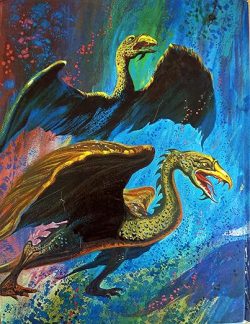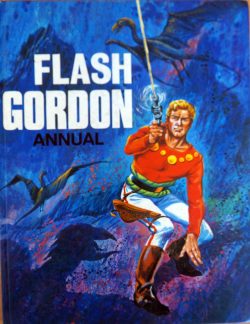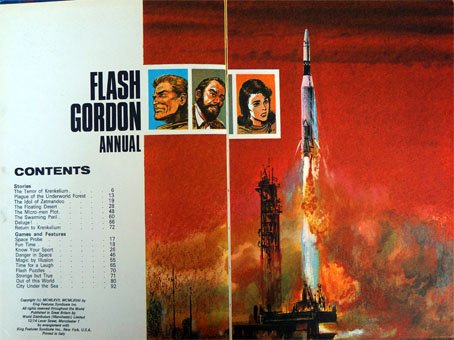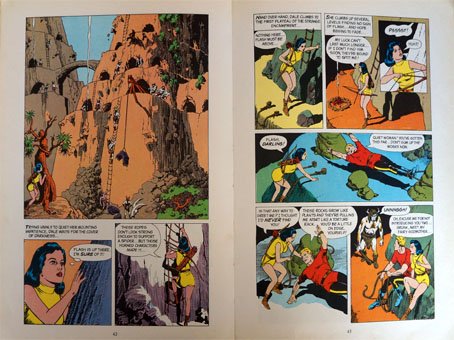

By anonymous staff of the Mick Anglo Studio, Dick Wood, Al Williamson, Don Heck & various (World Distributor’s [Manchester] Ltd.)
No ISBN – B06WGZR1KX
By most lights, Flash Gordon is the most influential comic strip in the world. When the hero debuted on Sunday January 7th 1934 (with the superb if now-dated Jungle Jim running as a supplementary “topper”) in response to revolutionary, inspirational, but clunky Buck Rogers (by Philip Nolan & Dick Calkins and which had also began on January 7th but back in 1929), a new element was added to the realm of fantasy wonderment: Classical Lyricism.
Where Rogers had traditional adventures and high science concepts, this new feature reinterpreted Fairy Tales, Heroic Epics and Mythology. It did so by spectacularly draping them in the trappings of the contemporary future, with varying esoteric “Rays”, “Engine” and “Motors” substituting for trusty swords and lances – although there were also plenty of those – and exotic flying craft and contraptions standing in for Galleons, Chariots and Magic Carpets.
Most important of all, the sheer artistic talent of Raymond, his compositional skills, fine line-work, eye for concise, elegant detail and just plain genius for drawing beautiful people and things, swiftly made this the strip all young artists swiped from.
When all-original comic books began a few years later, literally dozens of talented kids used the clean lined Romanticism of Gordon as their model and ticket to future success in the field of adventure strips. Most of the others went with Milton Caniff’s expressionistic masterpiece Terry and the Pirates (which also began in 1934 – and he’ll get his go another day).
At the time of this annual a bunch of Gold Key and King Features Syndicate licenses were held by Mick Anglo, who provide strip and prose material for UK weekly TV Tornado. It combined British-generated material with US comic book reprints in an era when the television influence of shows like Tarzan and Batman, and veteran features like Flash Gordon – who had a small screen presence thanks to frequent re-runs of his cinema chapter plays. The project was extremely popular, even though not always of the highest quality…
In 1966, newspaper monolith King Features Syndicate briefly got into comic book publishing again: releasing a wave of titles based on their biggest stars. These were an ideal source of material for British publishers, whose regular audiences were profoundly addicted to TV and movie properties. Moreover, thematically they fitted with World Distributors’ other licensed properties, which repackaged Western’s comics material like Star Trek, Beverly Hillbillies and Voyage to the Bottom of the Sea with domestically generated material – generally by Mick Anglo’s packaging company Gower Studios.
This Anglo-American (tee-hee!) partnership fulfilled our Christmas needs for decades, generating a wealth of UK Annuals, comics and the occasional Special, mixing full-colour US reprints with prose stories, puzzles, games and fact-features on related themes.
Flash Gordon Annuals appeared sporadically over the next few decades with this release from 1968 (and forward-dated for 1969) being the second. Like the previous book it leaned heavily on generic space opera adventure in prose-based illustrated vignettes leavened with some truly stunning comics tales recasting Flash, Dale Arden and Dr. Hans Zarkov as generalised space explorers undertaking non-stop voyages to the unknown by saving lesser civilizations from mischance, misfortune and monsters sentient and not.

The action opens with a prose return to last year’s main comic feature. Sporting full-colour illustrations peppered with mini general knowledge/science factoids, ‘The Terror of Krenkelium’ sees Flash and Zarkov head back underground to a subterranean kingdom where first-timer Dale meets her rival for Flash’s attention. Happily, Princess Darla regains her equilibrium and common sense when usurper Mogulari tries to kill the court and take over only to meet stern and fatal resistance from the upworlders…
‘Plague of the Underground Forest’ then finds our heroes revisiting a formerly idyllic aboriginal paradise planet whose deeply spiritual people are now racked with famine thanks to an invasion of super-rats. The problem is not destroying the immediate menace but convincing the despondent survivors to leave their ancestral lands for somewhere that can actually support them in the solution’s aftermath…
Astronautics quiz ‘Space Probe’ and a page of ‘Fun Time’ cartoons presage a switch to 2-colour illustration as prose thriller ‘The Idol of Zatamandoo’ sees the star travellers uncover the dark underbelly of another apparent paradise planet where a godlike being trades peace and perfection for the occasional human sacrifice. After a traditional quiz – ‘Know Your Sport’ – Flash, Dale and Zarkov return to Mongo to save Earth from being drowned by ‘The Floating Desert’ before prose pauses and this year’s strip quotient begins. Originating in US comic book Flash Gordon #6 (cover-dated July 1967) as ‘Cragmen of the Lost Continent’, here Bill Pearson & Reed Crandall’s sublime romp becomes ‘Flash Gordon meets the Cragmen of the Lost Continent’ as a trek through unknown regions of Mongo sees Dale in charge and kicking alien butt when Flash is swallowed by a monster and the old doctor breaks his leg.
Striving against uncredible beasts and hostile conditions she eventually rescues her captive hero from sinister mountain dwellers and is bringing him to safety when…

An abrupt return to words follows a full-colour board game delivering ‘Danger in Space’ (as long as you can find dice and counters) after which diversion our dynamic trio scotch ‘The Micro-Men Plot’: an invasion scheme by a despot able to shrink his all-conquering forces.
An activity page of conjuring tricks shares the how-to of ‘Magic by Illusion’ before strip thrills blast back with a short spy story also taken from Flash Gordon #6. Written by Gary Poole and limned by either Mike Roy and/or Frank Springer, it tells of Secret Agent X-9 in Japan to obtain at all costs ‘The Third Key of Power’.
It’s back to 2-tone visions and peerless prose as our heroes endure the strangest case of their lives after encountering an advanced culture of ants. ‘The Swarming Peril’ proves so fearsome Flash has his brain inserted into an insect’s skull to complete his mission…
‘Time For a Laugh’ affords more cartoon buffoonery before The Mazzlins try to eradicate humankind in a ‘Deluge!’, after which thrills pause for general knowledge and testing in ‘Flash Puzzles’ and ‘Strange But True’.
Prose poser ‘Return to Krenkelium’ finds the human heroes again going underground, with Princess Darla’s embattled people invaded by The Snakemen of Syndromeda – beings from even deeper in the planet’s core…
Crossword ‘Out of This World’ segues into comics and the conclusion of the Cragmen crisis as Flash faces ‘The Totem Master!’ before this slice of Christmas past fades away with another board game situated in a ‘City Under the Sea.’
Once upon a time this type of uncomplicated done-in-one media-tasty package was the basic unit of Yule fuel, entertaining millions of British kids, and still holds much rewarding fun for those looking for a simple and straightforward nostalgic escape.
MCMLXVII, MCMLXVIII by King Features Syndicate, Inc. All rights reserved throughout the world. The Amalgamated Press.
